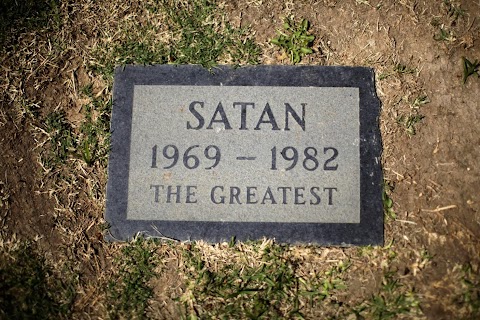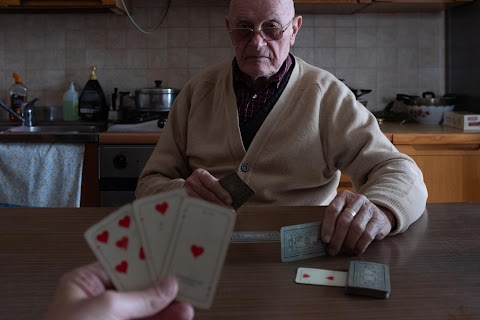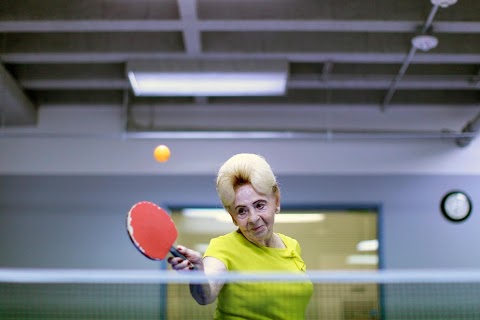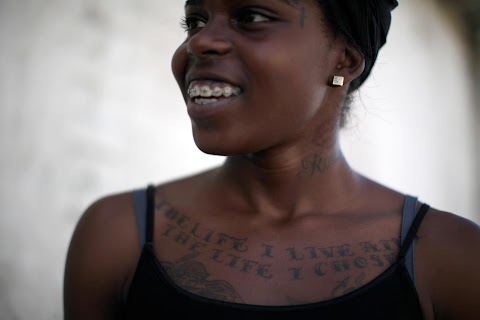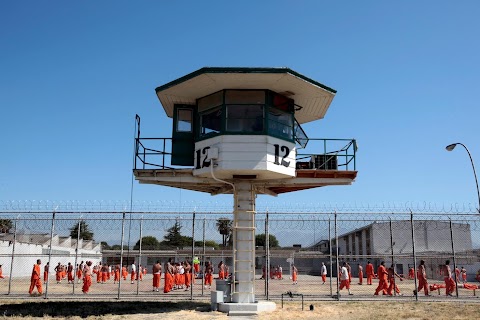
Overcrowding at Chino jail
 Lucy Nicholson
Lucy Nicholson
The Supreme Court has ordered the state of California to release more than 30,000 inmates over two years or take other steps to ease overcrowding in its prisons to prevent "needless suffering and death."
California's 33 adult prisons were designed to hold about 80,000 inmates but now hold about 145,000. The United States has more than two million people in state and local prisons. It has long had the highest incarceration rate in the world.

The California Institution for Men state prison in Chino is so overcrowded that 200 prisoners are sleeping in the prison gym.
Panorama:
Inmates stand in a gymnasium where they are housed due to overcrowding at the California Institution for Men state prison.

“I imagined walking in here as a new prisoner and taking in the 202 people I would be spending years in this room with”
The first inkling I had that it wasn’t going to be an ordinary day at work was the dress code; no tight or revealing clothing, no blue jeans, no blue shirts, no orange clothing, no jewelry, no cell phones.
For the first time, I thought of the possible mental state of the people I was visiting, and how little some of them would have to lose.
I had been in a car crash (not serious) the day before. I wasn’t expecting anything bad to happen to me inside the prison. But imagined that if it did it would be much the same kind of sudden violence coming out of nowhere.
I realized all my trousers that weren’t jeans were dressy. I thought of the absurdity of buying new clothes to visit a prison, and found a pair of (tight) brown corduroys. I dug in my boyfriend’s wardrobe and found an old black t-shirt that was long and baggy on me.
I asked him how I looked. He said brown and black was a bad color combination, but that I looked suitably dressed for the reception area for new prisoners.
I was visiting the California Institution for Men state prison in Chino, with Reuters television cameraman Krystian Orlinski and producer Dave Adhicary.
The U.S. Supreme Court has just ordered California to release more than 30,000 inmates over the next two years or take other steps to ease overcrowding in its prisons to prevent “needless suffering and death.” California’s 33 adult prisons were designed to hold about 80,000 inmates and now have about 145,000.
The U.S. has more than 2 million people in state and local prisons. It has long had the highest incarceration rate in the world.
The prison houses 5,982 inmates on a patch of arid farmland east of Los Angeles. As we stepped out into the parking lot we saw what looked like barracks behind a triple layer electric fence, topped with razor wire.
A crackle of machine gun fire broke the silence. Then another. I looked at Krystian and raised an eyebrow. “Yes, those were automatic weapons,” he answered.
We met the press officer, who told us there was a firing range inside the prison, so the officers could stay sharp. He began our tour.
First stop was the sensitive-needs exercise yard. Our guide explained that this was where they kept sex offenders, gang members who owed money, and other inmates who wouldn’t be safe living with other prisoners.
Most were walking slowly around the perimeter fence. Some waited in line to use the parallel bars in the center. One sunbathed on a bench.
I saw a prisoner with red hair and tattoos of Celtic knot patterns and shamrocks. The harsh midday sun beat down on his pale skin. I wondered why he didn’t wear a t-shirt. I thought of how much I relied on sun block, sunglasses and a hat, living in California. I noted that I’d never seen so many people with multiple tattoos in one place.
I photographed the inmates walking with a 70-200mm. I manually focused to compensate for the many layers of mesh fence. Some made gang signs, some smiled, some glared, some shouted out questions about who I was working for.
A rhythmic shouting cadence came from a building next to the exercise yard.
Our guide explained that gang members in jail viewed themselves as soldiers. They trained to be ready to fight at any time – with prison officers, other prisoners, upon their eventual release.
Even when they weren’t allowed out to exercise, they would work out together in their cells. One guy would shout through his cell bars, out to the echoing hallways, to set the pace as the other inmates would do push-ups in their tiny cells.
The prison officers all looked as if they were onto that game, and had built their upper body strength to match the prisoners pound for pound.
Prisoners sitting in small cages were our first sight as we walked inside. They are kept in the cages while waiting for medical or counseling appointments, or for permanent housing. A couple of women walked down the corridor, wearing bulletproof vests.
First we visited a two-person cell, where prisoners are typically housed.
Anthony Turner, 46, showed us around the tiny living quarters he shares with Daniel King, 25. When they both lie down in their bunk beds there is barely an inch of vertical space between them. A toilet and small basin are next to the beds. The only possessions in the cell were a few basic toiletries, some greetings cards, a photo of a pregnant woman and a poignant handmade card from a child.
“We miss you. xoxoxxoo. p.s. come visit soon!” it said, next to a drawing of a king.
Turner said he was given a 25 years to life sentence under the three strikes law. He is unlikely to be visiting anyone soon.
We visited a recreation room, and then a huge gymnasium, which are being used to house prisoners, due to the overcrowding.
As my eyes adjusted to the dim light of the gym, I imagined walking in here as a new prisoner and taking in the 202 people I would be spending years in this room with. They were a scary-looking bunch.
A heavy-set guy with tattoos all over his body and neck started shouting that he didn’t want to be on camera.
We walked up the stairs onto the platform where a female prison officer was sitting. I wondered how she could deal with working every day in this room full of aggressive men.
Another guard had the whole room in his gun sight through a window in the top left corner of the room.
One of the prison officers accompanying us said he had been spat at, bitten and stabbed during the time he had worked there. Another remarked that the sleeping quarters in the gym were not much different from the ones he had experienced in the U.S. Navy.
There are no rehabilitation programs inside the prison, and inmates have nothing constructive to do all day except for the brief periods when they can go outside to work out.
Some were sleeping, some reading, some playing cards or dice, one group was playing a Dungeons and Dragons game, one guy was sketching tattoo designs, another crowd was watching music videos on a small television. Most were wandering around or chatting.
I photographed inmates on the right side of the room, while checking out the belligerent prisoner with my left eye. He was staring at me.
Krystian and Dave started filming a group of prisoners, and very quickly the guy who didn’t want to be filmed, was in front and center of the camera.
I walked down and started photographing them with a wide angle lens. A lot of them were staring into the camera and all trying to simultaneously start conversations with me.
I decided I wanted to walk among the beds to take more natural looking photos. I asked a guard to follow me to watch my back, and he stood right behind me every time I stopped walking, aware of the remote possibility that I could be grabbed as a hostage. We moved fast, and before long were called back by the press officer.
On the drive home, I asked about the prison tattoos and Krystian talked about how prisoners who didn’t join gangs for protection were vulnerable to being raped in the bathroom at the back of the gym.
I recalled the inmates’ faces I’d seen with their varying degrees of resignation or defiance.
“I don’t know what I’d do if I had to go into a place like that,” said Krystian. “No-one ever really knows until they’re in that situation.”
